I'm trying to fetch time series from geographical coordinates (single points) from Google ERA5 Reanalysis data. The dataset is following:
import xarray
data = xarray.open_zarr(
'gs://gcp-public-data-arco-era5/co/single-level-reanalysis.zarr/',
chunks={'time': 48},
consolidated=True,
)
print("Model wind dataset size {:.1f} TiB".format(data.nbytes/(1024**4)))
print(data)
Model wind dataset size 28.0 TiB
<xarray.Dataset>
Dimensions: (time: 374016, values: 542080)
Coordinates:
depthBelowLandLayer float64 ...
entireAtmosphere float64 ...
latitude (values) float64 dask.array<chunksize=(542080,), meta=np.ndarray>
longitude (values) float64 dask.array<chunksize=(542080,), meta=np.ndarray>
number int64 ...
step timedelta64[ns] ...
surface float64 ...
* time (time) datetime64[ns] 1979-01-01 ... 2021-08-31T23:0...
valid_time (time) datetime64[ns] dask.array<chunksize=(48,), meta=np.ndarray>
Dimensions without coordinates: values
Data variables: (12/38)
cape (time, values) float32 dask.array<chunksize=(48, 542080), meta=np.ndarray>
d2m (time, values) float32 dask.array<chunksize=(48, 542080), meta=np.ndarray>
hcc (time, values) float32 dask.array<chunksize=(48, 542080), meta=np.ndarray>
istl1 (time, values) float32 dask.array<chunksize=(48, 542080), meta=np.ndarray>
istl2 (time, values) float32 dask.array<chunksize=(48, 542080), meta=np.ndarray>
istl3 (time, values) float32 dask.array<chunksize=(48, 542080), meta=np.ndarray>
... ...
tsn (time, values) float32 dask.array<chunksize=(48, 542080), meta=np.ndarray>
u10 (time, values) float32 dask.array<chunksize=(48, 542080), meta=np.ndarray>
u100 (time, values) float32 dask.array<chunksize=(48, 542080), meta=np.ndarray>
v10 (time, values) float32 dask.array<chunksize=(48, 542080), meta=np.ndarray>
v100 (time, values) float32 dask.array<chunksize=(48, 542080), meta=np.ndarray>
z (time, values) float32 dask.array<chunksize=(48, 542080), meta=np.ndarray>
Attributes:
Conventions: CF-1.7
GRIB_centre: ecmf
GRIB_centreDescription: European Centre for Medium-Range Weather Forec...
GRIB_edition: 1
GRIB_subCentre: 0
history: 2022-09-23T18:56 GRIB to CDM+CF via cfgrib-0.9...
institution: European Centre for Medium-Range Weather Forec...
pangeo-forge:inputs_hash: 5f4378143e9f42402424280b63472752da3aa79179b53b...
pangeo-forge:recipe_hash: 0c3415923e347ce9dac9dc5c6d209525f4d45d799bd25b...
pangeo-forge:version: 0.9.1
What is the best way to interpolate a time series from single geographical point?
The methods like .sel and interp don't work:
data['cape'].interp(dict(latitude=60, longitude=20))
ValueError: Dimensions {'longitude', 'latitude'} do not exist. Expected one or more of Frozen({'values': 542080, 'time': 374016})
